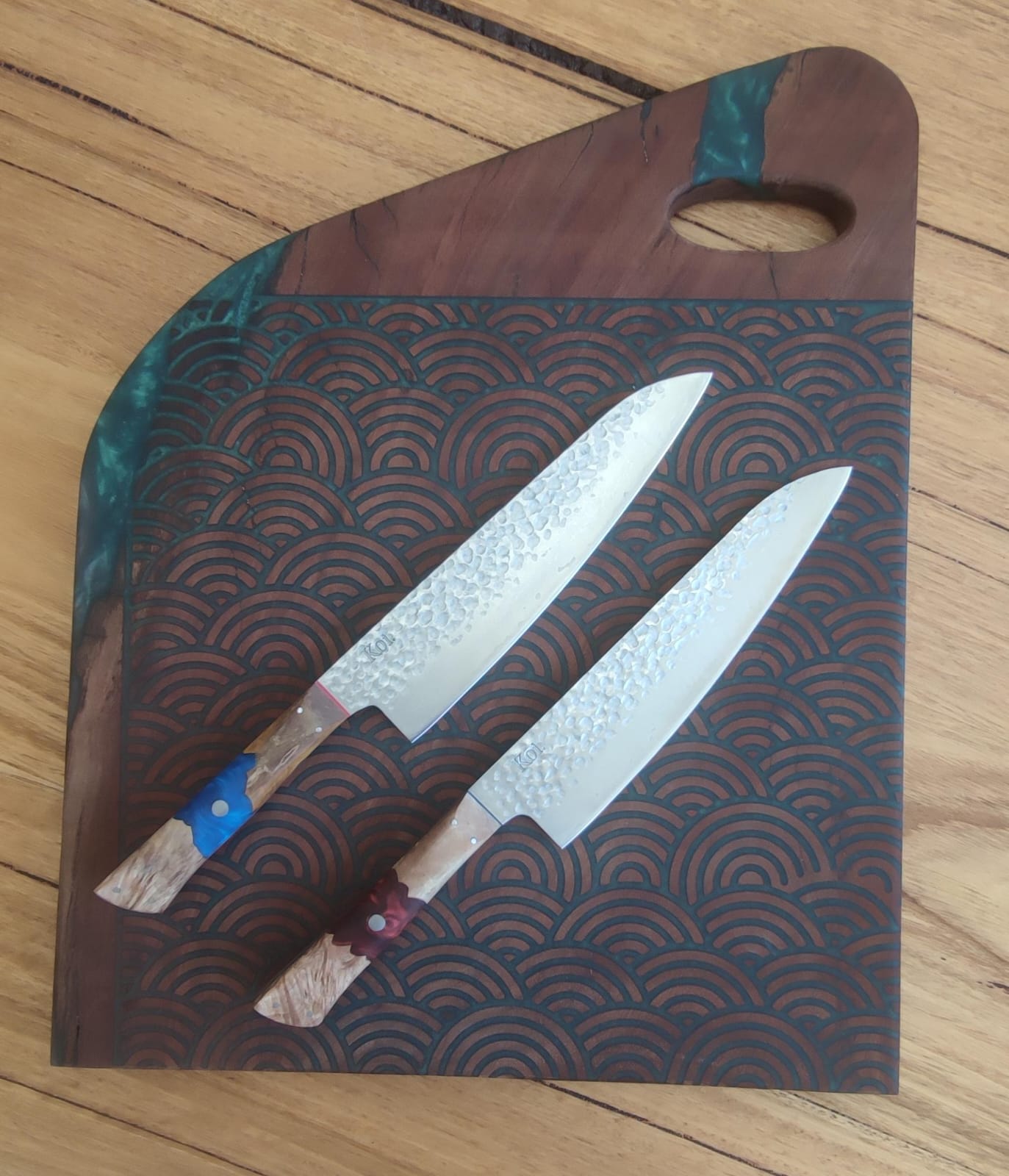Welcome to the world of Koi Knives, where culinary mastery meets innovation. This excursion will take us through two great knife ranges: The Big Red and Seki Range.
The Big Red Range of knives highlights Australian wildlife's raw beauty while embracing Japanese steel's precision. The sandblasting coating on these knives improves their performance by preventing food from sticking.
On the other hand, the Seki Range leads us to the heart of knife production, Seki, Japan. Here, decades of knowledge meet cutting-edge design. These knives have beautiful Australian wood handles.
Throughout this post, we'll delve into their distinct characteristics to help you make an informed decision for your culinary travels.
The Big Red Range: Australian Toughness Meets Japanese Craftsmanship
In the kitchen, you need tools that combine strength and precision. That's exactly what we aspired for with The Big Red Range. This collection combines the unrefined durability inspired by Australia's untamed fauna and the precise artistry of Japanese steel craftsmanship.
Inspiration Behind the Range
Australia, known for its unique wildlife and landscapes, served as the muse for The Big Red Range. Just like the feral creatures that roam its terrain, these knives are built to withstand the rigors of culinary challenges.
The Sandblasted Finish
One defining feature of this range is the sandblasted finish. This technique imparts a texture akin to hammered steel, creating microscopic irregularities on the blade's surface. These tiny 'bumps' might seem insignificant, but they play a pivotal role in the kitchen. They prevent food from clinging to the blade, ensuring that your slicing and chopping are seamless and efficient.
Overview of the Big Red Range
1. Chef's Knife (The Big Red)
- The kitchen's workhorse, this knife boasts VG10 steel, known for its sharpness and edge retention. The double-layer cladding adds strength and resilience.
2. Serrated Knife (The Croc)
- Designed for cutting through crusty bread or ripe tomatoes, "The Croc" combines precision with the jagged edge.
3. Boning Knife (The Tassie Devil)
- This knife ensures you get every bit of meat for filleting fish or deboning poultry.
4. Fillet Knife (The Barramundi)
- Crafted for delicate tasks like filleting fish, its flexibility and sharpness make it indispensable.
5. Barbecue All-Purpose (The Great White Shark)
- This Western-style Japanese Deba knife is your all-in-one tool for barbecue and grilling.
6. Barbecue Cimeter/Slicer ("The Brolga")
- Whether you're slicing steaks or carving roasts, "The Brolga" excels with its long, curved blade.
The Big Red Range is not just a collection of knives; it's a testament to the fusion of strength and precision, embodying the wild spirit of Australia in every cut.
The Seki Range: A Glimpse into Knife-Making Excellence
Let's journey into the heart of knife craftsmanship, where centuries of tradition meet modern excellence. Seki, nestled in Japan, isn't just a place; it's a legend in knife-making.
Historical Significance of Seki in Knife Making
Seki is more than just another name on the map. It's the birthplace of some of the world's finest knives. For generations, artisans in Seki have honed their craft, passing down techniques that have become the stuff of legends. When you hold a Seki knife, you hold a piece of this rich history.
Presentation of The Seki Range
Koi Knives proudly brings you The Seki Range, a tribute to this legacy. These knives are more than just tools; they embody Japanese precision and excellence.
Japanese Knife Starter Collection (3 Knives)
- The Petty: Your daily kitchen companion. Precise, versatile, and perfect for delicate tasks like peeling and trimming.
- The Gyuto: The chef's secret weapon. Its versatility and sharpness make it your go-to knife for chopping, slicing, and dicing.
- The Bunka: The all-rounder. From slicing veggies to boning meats, it's the Swiss Army knife of your kitchen.
Full Damascus Collection (6 Knives)
- The Gyuto: Trust it for all-purpose work. It's the culinary workhorse, from fine slicing to heavy chopping.
- The Bunka: Versatile like no other, it's your partner in precision tasks and artistic presentations.
- The Petty: The small wonder, ideal for those intricate jobs that demand finesse.
- The Nakiri: A vegetable's nightmare, it chops and dices with unmatched efficiency.
- The Santoku: Your versatile sidekick for diverse slicing and dicing needs.
- The Sujihiki: The slicer extraordinaire, perfect for sashimi, cured fish, or roast meats.
Highlighting the Use of Australian Wooden Handles
Adding an Australian touch, our Seki Range boasts handles crafted from Australian wood. This fusion of Japanese precision and Australian aesthetics enhances grip and adds a touch of uniqueness to your culinary experience.
With The Seki Range, you're not just buying a knife but investing in centuries of craftsmanship. It's a piece of history ready to become a part of your culinary journey.
Comparing Blade Construction: Full Tang vs. Partial Tang
Let's dive into a critical aspect of knife craftsmanship - the construction of the blade, specifically, full tang versus partial tang.
Explanation of Full Tang and Partial Tang
A knife's tang refers to the portion of the blade that extends into the handle. The tang runs the entire handle length in full tang knives, providing exceptional strength and stability. On the other hand, partial tang knives have a tang that extends only partway into the handle, often secured with adhesives or pins.
Advantages of Full Tang in The Big Red Range
In The Big Red Range, you'll find full tang knives. This design offers several advantages. The full tang adds substantial weight to the handle, creating a balanced feel in your hand. This balance enhances precision during cutting and reduces strain on your wrist. Moreover, it's incredibly robust, making these knives ideal for heavy-duty tasks like boning and slicing.
Considerations of Partial Tang in The Seki Range
The Seki Range, known for its Japanese craftsmanship, features partial tang knives. While these knives are lighter and often have an elegant aesthetic, they may need to be more suited for tasks requiring significant force, like breaking down large cuts of meat.
Impact on Knife Performance and Durability
The blade's construction significantly influences knife performance and durability. Full tang knives in The Big Red Range are workhorses, perfect for demanding culinary challenges. Partial tang knives in The Seki Range shine in precision tasks but require a gentler touch.
Remember, your choice depends on your cooking style and needs. Full tang may be your preference if you're all about versatility and power. If precision and finesse are your focus, partial tang knives may be your perfect match. Either way, both ranges maintain Koi Knives' commitment to quality and craftsmanship.
Weight Difference: Balancing Precision and Comfort
Now, let's dive into a crucial aspect of choosing the perfect knife – weight.
The Big Red Range excels in weight distribution. The sandblasted finish prevents food from sticking and ensures an even balance, offering precision in every slice. These knives feel substantial in your hand, providing the heft needed for controlled, accurate cuts.
On the flip side, The Seki Range emphasizes finesse. The lightweight design allows for nimble manoeuvring, ideal for intricate tasks. The focus here is on comfort during prolonged use, making it a versatile choice for various culinary adventures.
Remember, the right weight depends on your cooking style. Precision or comfort, the choice is yours.
Style Differences: Aesthetics and Cultural Influences
In the world of knives, style is more than just appearance; it reflects purpose and heritage.
Contrasting Design Elements of The Big Red Range
The Big Red knives are sandblasted and inspired by the raw beauty of Australian nature. This finish not only keeps food from sticking but also resembles the roughness of the Australian desert. It combines functionality with the raw charm of the outdoors.
Highlighting the Traditional Japanese Aesthetics in The Seki Range
The Seki Range, on the other hand, pays homage to centuries-old Japanese craftsmanship. Sleek, clean designs and wooden handles distinguish its knives. The aesthetics are inspired by Japanese minimalism, emphasizing accuracy and balance.
How Style Choices Reflect the Knife's Intended Use and Appeal
Remember that the style isn't only for show; it also corresponds to the knife's intended usage. The Big Red Range's raw charm accompanies its powerful performance, while The Seki Range's elegance supports its precise cutting. It's not just about looks; it's about selecting a knife that resonates with your culinary journey.
Conclusion
If you want the rugged poise of the Australian outback coupled with Japanese precision, the Big Red Range is the way to go. Its sandblasting finish prevents food from clinging, making every cut a breeze.
The Seki Range, on the other hand, is steeped in Japanese knife-making heritage and provides a variety of alternatives with fine hardwood handles. Ideal for individuals looking for the pinnacle of craftsmanship.
Remember that your knife is your kitchen buddy. Consider your cooking style, your demands, and how the knife feels in your hand. Trust your instincts and go with the one that speaks to your culinary soul.




